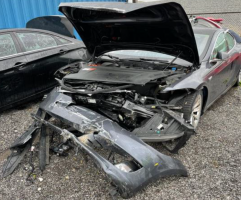
— A Tesla sudden acceleration lawsuit alleges an Illinois physician was critically injured when a 2018 Tesla Model S allegedly accelerated and struck vehicles and a building.
Harish Thakrar, M.D., purchased a 2018 Tesla Model S in June 2018. His wife, Nalini H. Thakrar, M.D., was driving her husband's Model S on November 11, 2021, in the parking lot of her medical office in Tinley Park, Illinois.
According to the acceleration lawsuit, she had her foot over the brake pedal preparing to stop in a parking spot when the Tesla Model S allegedly suffered from sudden unintended acceleration.
"The Model S vehicle proceed at uncommanded full power acceleration over the parking lot curb and a raised grass berm. The vehicle proceeded at uncommanded pull power acceleration across a two-lane roadway before traversing a second raised grass berm and subsequently striking several vehicles."
The lawsuit asserts the Model S eventually struck the building located across the two-lane roadway at or near full speed causing severe front-end damage, as seen in the above photo.
Plaintiff Nalini Thakrar says the crash caused numerous serious injuries including a fractured spine.
According to the Tesla acceleration lawsuit, the automaker programmed its systems to allow the Model S to engage with full throttle acceleration into walls, fences and other fixed objects.
Those systems include automatic emergency braking which the plaintiff says is not enabled when the Model S is traveling at slow speeds. And the emergency braking system is allegedly programmed to deactivate when it receives instructions from the accelerator pedal to drive full speed into fixed objects.
The plaintiff alleges the Model S does not automatically apply the brakes or it will stop applying the brakes, “in situations where you are taking action to avoid a potential collision.”
These situations include the driver turning the steering wheel sharply, pressing the accelerator pedal or pressing and releasing the brake pedal.
The Tesla sudden acceleration lawsuit also mentions a system called Obstacle-Aware Acceleration, a feature introduced in 2018. The system should “reduce the impact of a collision by reducing motor torque and in some cases applying the brakes” if the vehicle detects an object in its path.
The lawsuit alleges the system is triggered when a driving gear is engaged, the vehicle is stopped or traveling less than 10 mph and the vehicle detects an object in its immediate driving path. The plaintiff argues this is the time when sudden unintended acceleration usually occurs in Tesla vehicles.
Tesla allegedly created the system because the Model S and other vehicles were experiencing sudden acceleration, but the plaintiff says the feature still allows incidents like hers to occur.
When sudden uncommanded acceleration occurs, the vehicles lose control as the event overrides various Tesla systems.
Tesla Sudden Acceleration Data
The Tesla acceleration lawsuit says the automaker refuses to provide the plaintiff with data from the Model S, but Tesla says the crash occurred because the plaintiff physically pressed the accelerator pedal “100%” continuously for about 8 seconds.
However, the plaintiff insists she never pressed the accelerator pedal 100% during the time of the crash.
The acceleration lawsuit also argues Tesla's claim is "physically impossible considering the speed, distance traveled, and the various obstacles and objects the Model S violently struck before colliding with a building."
Multiple allegations have been thrown at Tesla over the years regarding alleged sudden unintended acceleration. In January 2020, the National Highway Traffic Safety Administration said it had received a defect petition which alleged sudden acceleration had caused more than 200 Tesla crashes.
The petitioner told NHTSA that Tesla should recall all Model S, Model X and Model 3 vehicles beginning with model year 2013 vehicles.
Federal safety regulators reviewed all Tesla complaints and crash allegations and analyzed videos and event data recorders collected from Model S, Model X and Model 3 vehicles.
NHTSA eventually denied to open a Tesla sudden acceleration investigation because the alleged acceleration problems were caused by drivers pressing the accelerator pedals.
Regulators also said in every case where data was available, the evidence showed crashes caused by alleged acceleration problems were caused by driver "pedal misapplication."
The Tesla sudden acceleration lawsuit was filed in the U.S. District Court for the Northern District of Illinois: Nalini H. Thakrar v. Tesla, Inc., et al.
The plaintiff is represented by Taxman, Pollock, Murray & Bekkerman, LLC.




